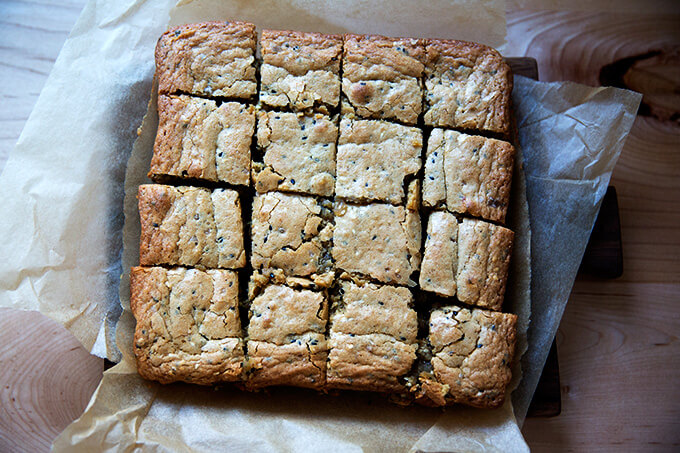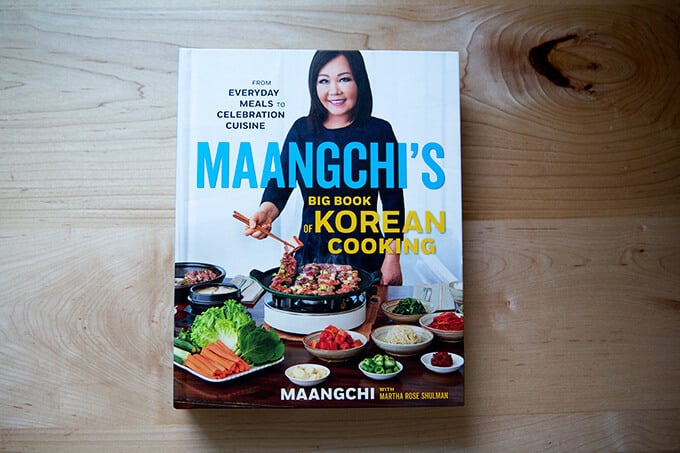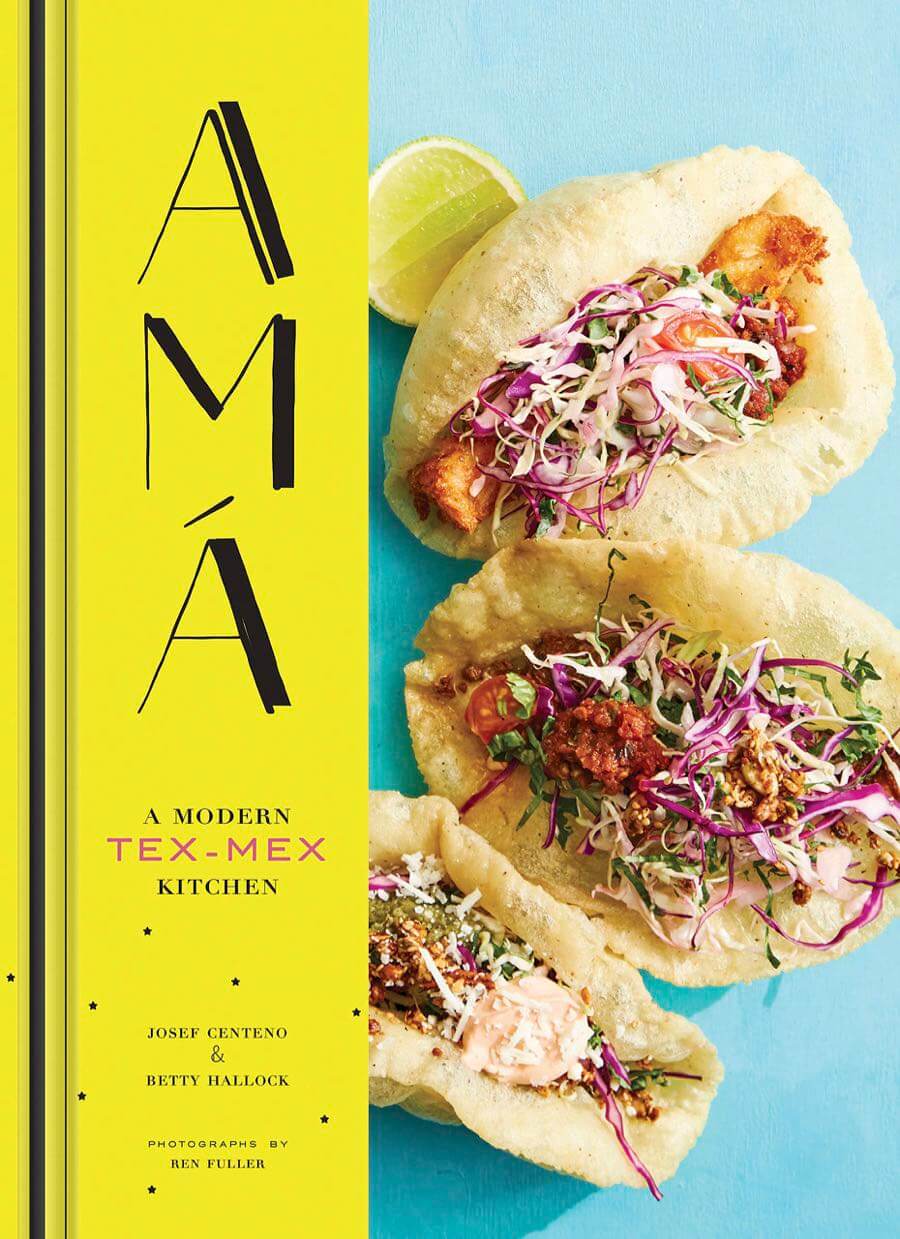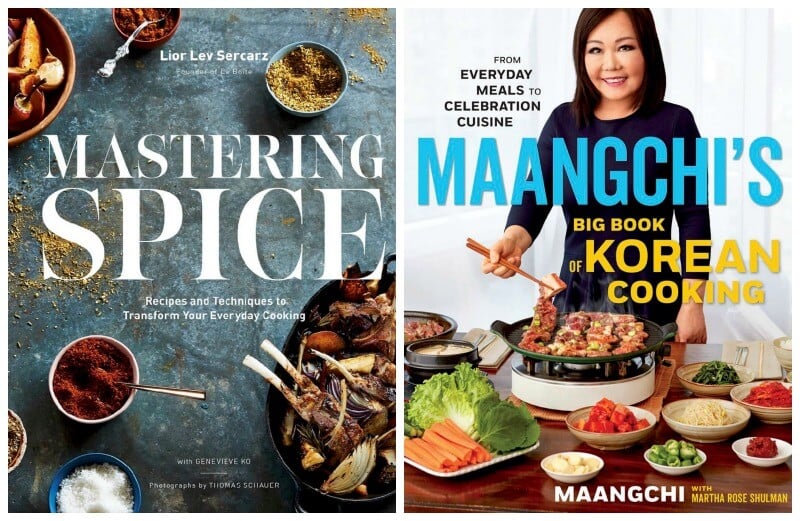5 “Spicy” New Cookbooks: A Chat with Margaret Roach
This post may contain affiliate links. Please read my disclosure policy.
Earlier this fall, Margaret Roach and I spent some time cruising around the cookbook table at HGS Home Chef and noticed a theme: spice!
And so, for our annual cookbook chat, we’ve narrowed the focus to cookbooks whose recipes and resources will help spice things up in the kitchen. These are the five books we discuss (with the exception of Amá, due to time constraints):
- Sababa by Adeena Sussman
- The Gaijin Cookbook by Ivan Orkin and Chris Yin
- Mastering Spice by Lior Lev Sercarz
- Maangchi’s Big Book of Korean Cooking by Maangchi
- Amá by Josef Centeno and Betty Hallock
Thanks to these new books, I’ve been enjoying: herby tahini sauce with harissa Brussels sprouts, stir-fried udon with cabbage, japchae with mushrooms and scallions, roasted vegetables with fennel and sumac, and tahini blondies with sesame seeds and cardamom.
But just as much as I am enjoying cooking from each of these cookbooks, I am enjoying reading them — the stories in each are captivating. I’ve reviewed each briefly below.
Listen to my chat with A Way to Garden’s Margaret Roach here.
Also: There’s a giveaway! I’m giving away a copy of Maangchi’s Big Book of Korean Cooking. Margaret’s giving away a copy of Mastering Spice. Details below.
UPDATE: Winner is Nancy Schwartz. I have emailed you.
PS: Margaret Roach’s Garden is Magical
PPS: Soup’s On! A Chat with Margaret Roach
Maangchi’s Big Book of Korean Cooking
If you are familiar with Maangchi, you’ve likely watched one of her YouTube videos. But in the intro to Maangchi’s Big Book of Korean Cooking, Maangchi writes that while videos are great for demonstrating technique, they don’t show the larger picture of how recipes fit together to make up a cuisine.
But MBBKC does. It feels encyclopedic, a comprehensive guide to Korean cooking from how to shop and stock a pantry to the recipes themselves, which extend from banchan (small side dishes) to street food to one-bowl meals.
There is even a chapter dedicated to the vegan recipes she learned from a group of nuns while visiting a Buddhist temple in the mountains.
Maangchi is funny, and I love what she says about plating: she’s not into serving a tiny amount of food on a small plate, preferring instead to plate “mountain” style, in which everything is heaped into a large, gently sloping mound, which she says reflects her culture’s most important value: generosity.
I made her recipe for japchae, a dish made with translucent sweet potato starch noodles, lots of vegetables, and meat if you wish. Get the recipe: Vegetarian Japchae
The Gaijin Cookbook
The word “gaijin” means foreigner or outsider but implies “intruder.”
In the intro to The Gaijin Cookbook, written by Ivan Orkin and Chris Ying, Ivan writes: “Even though I’ve lived in Japan for the better part of three decades, speak Japanese fluently, have opened two successful ramen shops in Tokyo, and am raising three half-Japanese kids, I’m still a gaijin. I can’t help it, just like I can’t help being head over heels in love with Japan.”
Ivan loves both the culture and the food of Japan, and with The Gaijin Cookbook, he hopes to dispel the idea that all Japanese food is “precious and high flying stuff.”
He thinks in general Japanese food gets treated with an over-the-top reverence, but notes that “a Japanese life encompasses the same range of situations as an American one. There are busy weeknights and weekends when you feel ambitious, picky kids, special occasions, dreary winters, sweltering summers, picnics, potlucks, parties, and hangovers. And there’s food for every occasion.”
The Gaijin Cookbook is not a manual for making perfect sushi or a comprehensive guide to Japanese food. The recipes extend from mostly simple to more elaborate (homemade dumplings or dan dan noodles or temaki (hand rolls)) but the section I’m loving the most is the chapter about Teishokuya, which Ivan relates to an American diner: cheap, everyday Japanese food in its purest form.
Thanks to the book, I bought a big bag of frozen udon noodles, pictured above, and they are SO nice to have on hand as fresh udon noodles can be difficult to find. I made the stir fried udon with cabbage and loved it, and what I’m loving about the book is that if you have soy sauce, mirin, miso, and sake on hand, you can make so many of the recipes.
Final thought: Throughout the book, Ivan reflects on what he’s learned from the Japanese culture as a whole, such as: care for others, not getting in other’s way, reading the air. I love these little reflections and stories — it’s such a great read.
Amá: A Modern Tex-Mex Kitchen
Amá tells the story of Los Angeles chef, Josef Centeno, who grew up in San Antonio, Texas, but wanted to get away. In the intro he writes he once “turned his back” on Tex-Mex cuisine.
With aspirations to be a chef, a young Josef moves away from home, heading first to NYC and eventually to cities all over the country cooking French, Japanese, and Spanish cuisines in Michelin 3-star kitchens.
But when he finds himself thinking about Tex-Mex, the cuisine of his childhood, he returns to San Antonio. And after he eats all the tacos and queso he can, he discovers this is not the food he’s after either.
He’s searching, he realizes, for the food of his family, of his Amá (his grandmother), of a Tex-Mex cuisine the modern, commercialized version has bastardized.
Josef describes the food he grew up with as “simple cooking that [isn’t] authentically Mexican but not the melted-cheese-topped stuff people usually talk about when describing Tex-Mex.”
Contrary to what many people think, Tex-Mex can be very vegetable forward — the vegetable dishes are not limited to salsa and guacamole — and the influences can be diverse. Tex-Mex, moreover, doesn’t have to be super fatty; it can rely on spices to add flavor, not the deep fryer or heaps of queso and sour cream.
And like any cuisine, Tex-Mex, evolves and adapts.
I have not cooked any of the recipes yet but I’m feeling inspired by the many fresh, bright flavors. On my to-do list: pick up a ton of dried chilies along with Mexican oregano to make the Amá spice mix, a blend that finds its way into many of the recipes.
Sababa
“Sababa” means “everything is cool” or “it’s all good,” and as you flip through Adeena Sussman’s Sababa, this is the feeling you get — from her morning ritual visiting a local market, the Shuk HaCarmel, a place she describes as her “constant companion,” to her trips to world-renowned restaurants serving the best hummus and falafel, Adeena gives you a real glimpse into her dreamy Tel Aviv kitchen.
And with Sababa, she makes all of this food accessible to the home cook. In addition to providing resources for where to buy pantry staples, she gives recipes for homemade versions or alternatives if you can’t buy or make either. For instance, if you can’t find pomegranate molasses, you can make your own in 45 minutes with a bottle of pomegranate juice and honey. And if you can’t find dried Persian limes, you can use lime zest and fresh lime juice.
I made her basic tahini sauce recipe, which is delicious, and I made one of the variants by puréeing it with a ton of parsley and cilantro. I topped this herby purée with one of her suggested garnishes, harissa Brussels sprouts, which also were delicious. The combination as a whole with the many variations is something I foresee re-visiting often.
Sababa is not a comprehensive guide to Israeli food, but rather a window into how Adeena cooks right now. She uses a lot of fresh produce, a lot of acidity, and a lot of herbs, spices, and toasted nuts — I love this style of cooking.

Tahini blondies from Sababa.
Mastering Spice
Mastering Spice is much more than a book about blending spices and learning about which spices go with which foods: it’s about cooking techniques that incorporate spice, and it’s about building off these basic techniques to transform everyday cooking.
Lior writes: “Rather than swap methods for roasting vegetables or simmering beans, I simply switch the seasonings. This is a great way to learn how to cook: mastering basic techniques makes it easier to master new seasonings.”
For example, a creamy carrot soup can be flavored with smoked paprika and cumin or basil and oregano or turmeric and lime. This same creamy carrot soup, incidentally, can be used to sauce pasta, a dish Lior garnishes with poppy seeds, which looks/sounds divine.
Mastering Spice is not a vegetarian cookbook, but there is a focus on non-meat dishes, because that’s mostly how Lior cooks these days.
I’m inspired by his use of spice in unexpected ways. For instant, he uses curry spices in dessert and cinnamon on meat. He writes: “No one spice or blend belongs to one culture or place: ras-el-hanout tastes amazing in a strawberry salad.”
This post may contain affiliate links. Please read my disclosure policy.

















186 Comments on “5 “Spicy” New Cookbooks: A Chat with Margaret Roach”
Bulgogi is a spicy soup I would like to learn to make. We eat it at a local Korean restaurant and it is wonderful, especially on a cold rainy day.
I keep it fairly simple when it comes to spicy food and am starting to weave it more into my kitchen repertoire, mostly with chili flakes in pasta or chili oil with dumplings right now. But I’m itching to recreate some amazing spicy northern Thai dishes like somtum or larb that I’ve had in the beautiful Thai restaurants!
Pasta puttanesca is my favorite spicy dish but I would love to be introduced to the world of Korean cooking.
I love Korean spicy tofu soup which seems difficult to make as it has so many components.
Thanks for doing this giveaway!
I don’t cook “spicy”
Time to learn!
Count me in !
I make a cauliflower wing recipe that is baked and very spicy.
I like Korean food but rarely cook it at home. Maangchi’s Big Book of Korean Cooking might very well change that.
I would love to learn to make Nashville Hot chicken. It looks so good
The Korean market in my neighborhood just moved into supermarket sized space and I would love to explore with more confidence. I love bibimbap so keep defaulting to that but want to try so much more.
count me in. My wife is an excellent cook and each year I give her a new cook book, of which I am the biggest beneficiary in getting new and delicious meals!! Both books look great.
Just a few comments here. First time I tried sumac – made Milk Street’s tomato salad with sumac and it was “interesting”. It was described as lemony. However I found it sour tasting. I wonder if that’s the way sumac is supposed to taste? Also – why is cardamom so expensive right now? Like $9 at the grocery store?! And all I need is a little bit. Lastly, Ms. Roach will be on repeat on the upcoming “Growing A Greener World” show on CPTV Spirit channel on 12/2 1030 am (set the dvr)! Ps I love all of Alexandra’s recipes including her breads – her cook book is awesome!
I love to cook anything with chorizo 😁❤️
The best General Tso’s Chicken I’ve ever eaten was at The Flaming Wok in Charlottesville, VA. They also made the best Chinese mustard—it would set your sinuses on fire, but had the most wonderful flavor. We lived there for 2 years in the mid- to late 1990’s, and I ate GTC frequently! Over 20 years, and I still haven’t had a decent serving of this dish anywhere. I would love to have a good recipe for GTC :).
I have not tried this type of cooking but we like spicey foods.
I would love to learn more about dried Chili’s and making spicy Mexican salsas. Thanks!
Would love to make Korean Jjiage
I always use dry herbs like oregano and rosemary. Them are fantastic!
I love anything curry…Thanx for the chance to win…
I love spices and very flavourful food. Currently I’ve become intrigued by cardamom and how it can flavour Swedish buns and Indian curries. It is delicious!
I’ve made Maangchi’s cheese buldak about 10 times now– I can practically make it in my sleep– and every time I’m still blown away by how simple yet incredibly delicious it is. Definitely in the top five best things I’ve ever eaten.
Someday I will learn to make Ethiopian special tibs, but so far it’s still something I can only get in a restaurant.
Happy Cooking.
I made Japchai last night from your post because it looked wonderful and I just happened to have all the necessary ingredients. I thought it was amazingly easy – ONE POT! We ate it with Gojuchang and loved it. Thank you!
Confident – Chicken curry
Want to Learn – Schezuan cuisine
I love Maangchi’s YouTube!!!! A really simple spicy thing I like to make is a zucchini stir fry with gochujang. I’d love to win this and learn some more korean techniques/flavors!! Thanks for hosting this!!
I would love to learn how to make Pad Prik Pow. A delicious dish at a local Thai restaurant!
I’d really love to make authentic Pad Thai well. 😫
I feel pretty confident with kimchi. All thanks to Maangchi! After visiting South Korea a few years ago I fell in love with the cuisine. So excited to see her new book!
i have mastered radish kimchi and my cabbage kimchi needs work! i wonder if i can ever make it as good as mama…
It is dead simple, but I tried it earlier this year and haven’t been able to stop eating it: Priya Krishna’s chaat masala toast from Indian-ish
I dont think I have mastered a spicy dish. But I love to eat spicy food! I’ve been trying to make some curry dishes but haven’t found one I love yet! I am also really big on sweet and spicy. I canned salsa this year and we had a few batches that were the perfect mix of sweet with a little heat!
I’m fascinated by the idea of harissa but I can’t handle the spice. I want to try to make it sometime soon but cutting back on the spiciness. I want the flavor with just a bit of heat. I did that with the skhug recipe you posted a while back and I love it. I make it with Anaheim peppers almost monthly and I slather it thick on toast or sandwiches and it’s just so fresh.